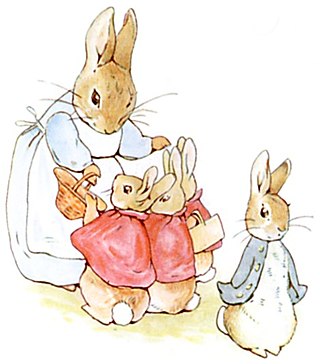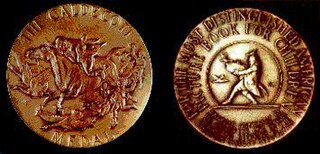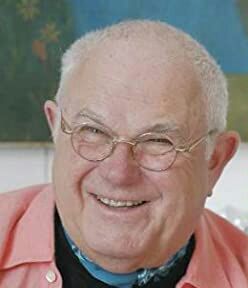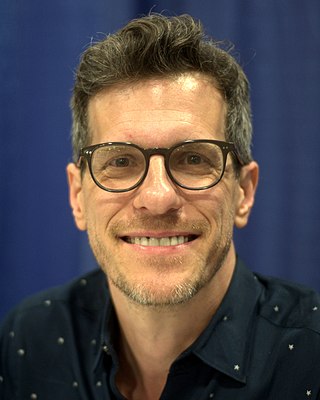
A picture book combines visual and verbal narratives in a book format, most often aimed at young children. With the narrative told primarily through text, they are distinct from comics, which do so primarily through sequential images.

The Randolph Caldecott Medal, frequently shortened to just the Caldecott, annually recognizes the preceding year's "most distinguished American picture book for children". It is awarded to the illustrator by the Association for Library Service to Children (ALSC), a division of the American Library Association (ALA). The Caldecott and Newbery Medals are considered the most prestigious American children's book awards. Besides the Caldecott Medal, the committee awards a variable number of citations to runners-up they deem worthy, called the Caldecott Honor or Caldecott Honor Books.

Goosebumps is a series of children's horror novels written by American author R. L. Stine. The protagonists in these stories are teens or pre-teens who find themselves in frightening circumstances, often involving the supernatural, the paranormal or the occult. Between 1992 and 1997, sixty-two books were published under the Goosebumps umbrella title. R. L. Stine also wrote various spin-off series, including, Goosebumps Series 2000, Give Yourself Goosebumps, Tales to Give You Goosebumps, Goosebumps Triple Header, Goosebumps HorrorLand, Goosebumps Most Wanted and Goosebumps SlappyWorld. Additionally, there was a series called Goosebumps Gold that was never released.
Cynthia Rylant is an American author and librarian. She has written more than 100 children's books, including works of fiction, nonfiction, and poetry. Several of her books have won awards, including her novel Missing May, which won the 1993 Newbery Medal, and A Fine White Dust, which was a 1987 Newbery Honor book. Two of her books are Caldecott Honor Books.
Leo Dillon and Diane Dillon were American illustrators of children's books and adult paperback book and magazine covers. One obituary of Leo called the work of the husband-and-wife team "a seamless amalgam of both their hands". In more than 50 years, they created more than 100 speculative fiction book and magazine covers together as well as much interior artwork. Essentially all of their work in that field was joint.

Thomas Anthony "Tomie" dePaola was an American writer and illustrator who created more than 260 children's books, such as Strega Nona. He received the Children's Literature Legacy Award for his lifetime contribution to American children's literature in 2011.

James John Patrick Murphy was an American author. He wrote more than 35 nonfiction and fiction books for children, young adults, and general audiences, including more than 30 about American history. He won the Margaret A. Edwards Award from the American Library Association in 2010 for his contribution in writing for teens.

Ed Tse-chun Young was a Chinese-born American illustrator and writer of children's picture books and tai chi instructor. He has received many awards and recognitions, including the Caldecott Medal and Lifetime Achievement awards for his contributions as a children's illustrator.
Donald Crews is an American illustrator and writer of children's picture books. In 2015, the American Library Association (ALA) honored him with the Children's Literature Legacy Award, recognizing his lasting contribution to children's literature.

Paul Goble was a British-American writer and illustrator of children's books, especially Native American stories. His book The Girl Who Loved Wild Horses won a Caldecott Medal in 1979.

David Díaz is an American illustrator of children's books. He won the 1995 Caldecott Medal for U.S. picture book illustration recognizing Smoky Night by Eve Bunting. He currently lives in Carlsbad, California.

Chris Raschka is an American illustrator, writer, and violist. He contributed to children's literature as a children's illustrator.
Margaret Crosby "Peggy" Rathmann is an American illustrator and writer of children's picture books.

Walter Dean Myers was an American writer of children's books best known for young adult literature. He was born in Martinsburg, West Virginia, but was raised in Harlem, New York City. A tough childhood led him to writing and his school teachers would encourage him in this habit as a way to express himself. He wrote more than one hundred books including picture books and nonfiction. He won the Coretta Scott King Award for African-American authors five times. His 1988 novel Fallen Angels is one of the books most frequently challenged in the U.S. because of its adult language and its realistic depiction of the Vietnam War.

David Shannon is an American writer and illustrator of children's books. Shannon grew up in Spokane, Washington. He graduated from the Art Center College of Design and now resides in Los Angeles. In 1998, he received the Caldecott Honor for his No, David!. He has also written A Bad Case of Stripes, How Georgie Radbourn Saved Baseball, and The Amazing Christmas Extravaganza. Shannon illustrated Audrey Wood's The Bunyans, Rafe Martin's The Rough Face Girl, various books by Jane Yolen, including The Ballad of the Pirate Queens and Encounter, as well as Melinda Long's How I Became a Pirate and Pirates Don't Change Diapers.

Peter Sís is a Czech-born American illustrator and writer of children's books. As a cartoonist his editorial illustrations have appeared in Time, Newsweek, Esquire, and The Atlantic Monthly. In 2012 he received the Hans Christian Andersen Medal for his "lasting contribution" as an illustrator of children's literature.
David Small is an American writer and illustrator who is best known for children's picture books. His books have been awarded a Caldecott Medal and two Caldecott Honors, among other recognition.

Brian Selznick is an American illustrator and author best known as the writer of The Invention of Hugo Cabret (2007), Wonderstruck (2011), The Marvels (2015) and Kaleidoscope (2021). He won the 2008 Caldecott Medal for U.S. picture book illustration recognizing The Invention of Hugo Cabret. He is also known for illustrating children's books such as the covers of Scholastic's 20th-anniversary editions of the Harry Potter series.
Earl Bradley Lewis is an American artist and illustrator. He is best known for his watercolor illustrations for children's books such as Jacqueline Woodson’s The Other Side and Jabari Asim’s Preaching to the Chickens: The Story of Young John Lewis.

Radiant Child: The Story of Young Artist Jean-Michel Basquiat is a 2016 picture book biography by Javaka Steptoe about Jean-Michel Basquiat. Using a style similar to Basquiat's, the book tells the story of his childhood and early career. It won the 2017 Caldecott Medal and Coretta Scott King Illustrator Award for its illustrations.














